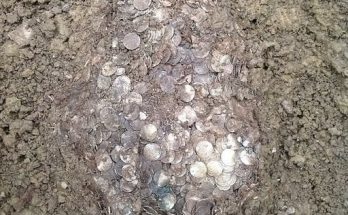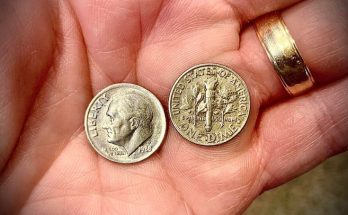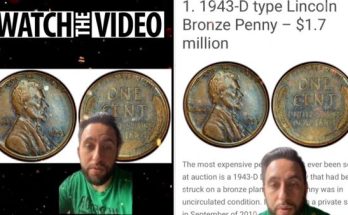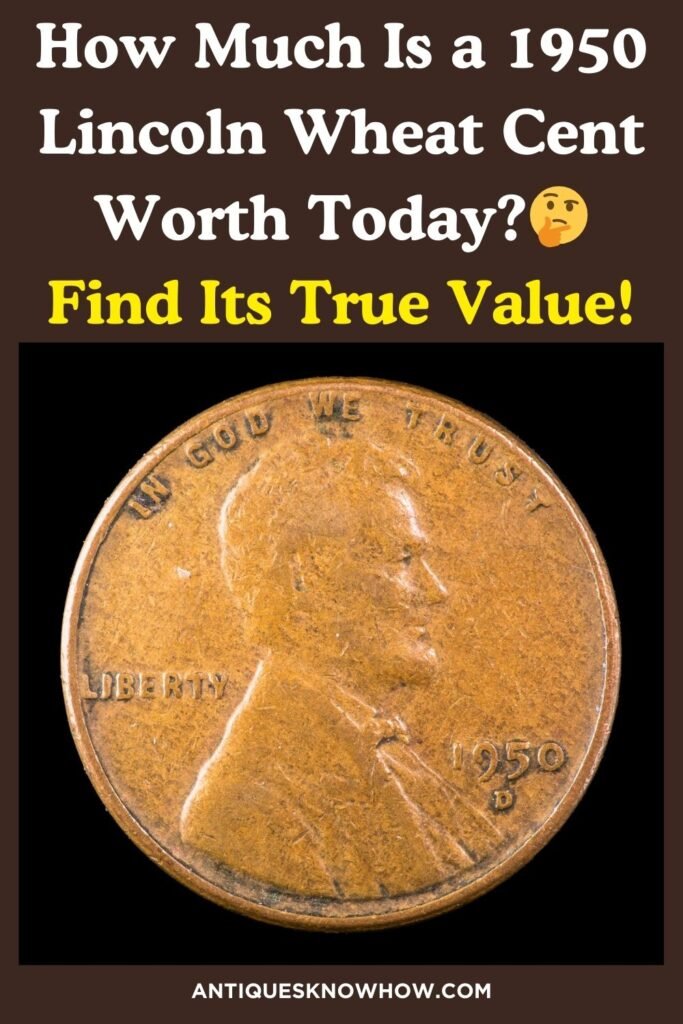
The average value of a 1950 Lincoln Wheat penny in average or circulated condition is approximately $0.02-0.03 or 2-3 cents. However, uncirculated coins can reach up to $15,000, depending on factors, such as condition, color, and errors.
Brief History of 1950 Lincoln Wheat Cent
The 1950 Lincoln Wheat penny represents a significant year in the long-running series that began in 1909. By 1950, the Lincoln cent had been a common coin in American pockets for over four decades, carrying Victor David Brenner’s iconic portrait of Abraham Lincoln and wheat ears reverse design.
This particular year saw substantial mintage across three facilities: Philadelphia, Denver, and San Francisco. The 1950 issue came during a period when the U.S. Mint was still producing cents from the same 95% copper alloy that had been used since 1864, maintaining the traditional reddish-brown appearance that collectors prize today.
💌 Daily One Friendly Email from Me on Old & Antique Wonders
One email, 5 minutes, countless discoveries. No SPAM, just our shared love for old treasures.
This coin is quite valuable today as it’s one of the last Lincoln cent with the wheat reverse as it would change to the modern Memorial Cent design in 1958!
| 1950 Lincoln Wheat Cent | Key Features & Facts |
| Coin Composition | 95% Copper, 5% Tin and Zinc |
| Minting Location | Philadelphia, Denver, San Francisco |
| Minting Year | 1950 |
| Face Value | 1-cent (0.01$) |
| Weight | 3.11 grams |
| Diameter | 19.05 mm |
| Thickness | 1.52 mm |
| Designer | Victor David Brenner |
| Mint Marks | D – Denver S – San Francisco No Mint Mark – Philadelphia |
| Total Mintage | 726,141,383 coins |
How to Identify a 1950 Lincoln Wheat Penny
The first step in assessing the value of your 1950 Lincoln cent is to identify its features and design, which prove its authenticity!
1950 Lincoln Cent Obverse:
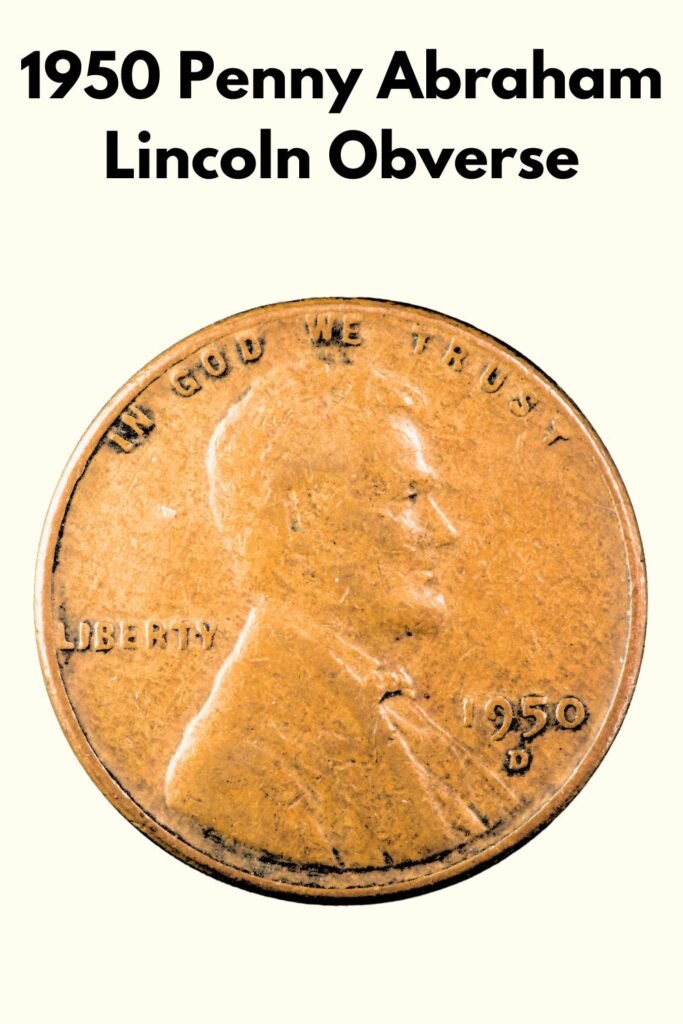
- A right-facing portrait of Abraham Lincoln
- “IN GOD WE TRUST” at the top
- “LIBERTY” to Lincoln’s left (back)
- The mint date “1950” to Lincoln’s right
- The mint mark S or D, if present, below the date
- Designer’s initials “VDB” on Lincoln’s shoulder (hard to see)
1950 Lincoln Cent Reverse:
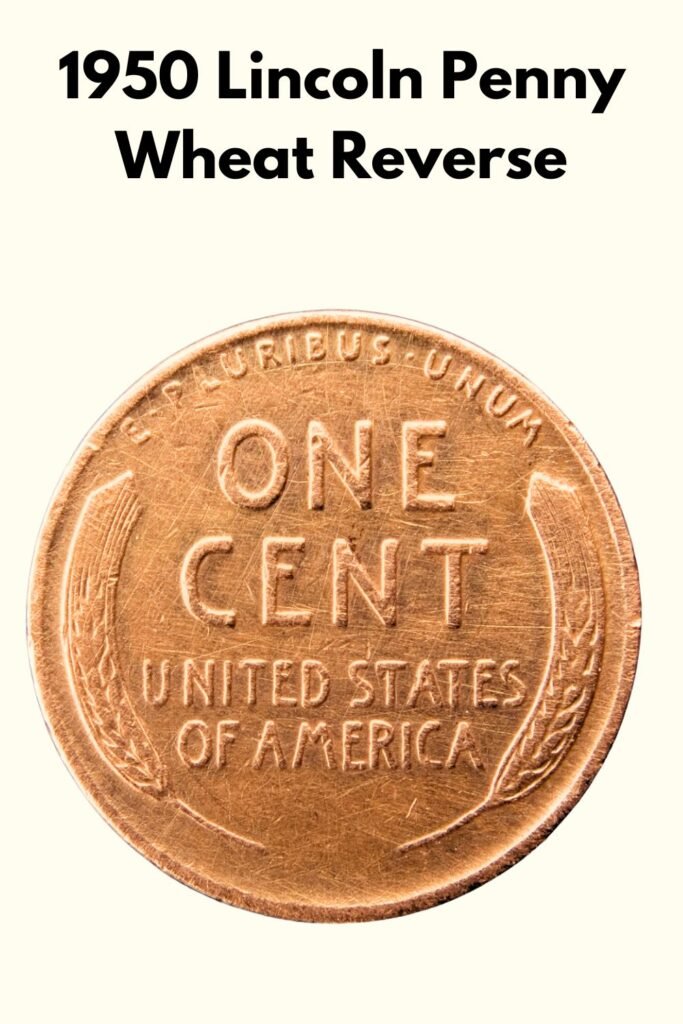
- “ONE CENT” in large letters in the center
- “UNITED STATES OF AMERICA” below the denomination
- Two wheat stalks surrounding the denomination & nation’s name
- “E PLURIBUS UNUM” at the top
Coin Composition, Size, and Dimensions
The 1950 Lincoln Wheat penny follows the standard composition established in 1909, consisting of 95% copper and 5% tin and zinc. This metallic mixture gives the small cent its distinctive reddish-brown color and a precise weight of 3.11 grams.
Besides, each penny measures 19.05 millimeters in diameter, with a thickness of 1.55 millimeters and a non-reeded smooth edge. Identifying these details is crucial to find out whether your 1950 penny is real or counterfeit.
4 Key Factors to Find a 1950 Lincoln Penny Value
Once you’ve verified all the physical details of your 1950 Lincoln cent, the next step is to assess its value based on the condition, any special mint mark and minting errors that it bears!
1. Coin Grades and Colors
The condition of a 1950 Lincoln Wheat penny is the first and most important factor influencing its value. While you can check the condition yourself based on the amount of wear and tear and toning, professionally graded coins are considered more valuable.
The coins are graded on a scale ranging from P-1 (poor) to MS-70 (Gem Mint State), with higher grades meaning a better condition and higher values. Here, Good to Very Good examples (G-4 to VG-8) and Fine to Very Fine (F-12 to VF-30) 1950 pennies are generally worth a few cents.
The uncirculated grades, MS-60 to MS-63 pieces typically bring $51-5, MS-64 examples command $7-10, while MS-65 specimens can bring $15-25. The premium grades of MS-66 and MS-67 show exceptional quality and can achieve values $200 to $1,200.
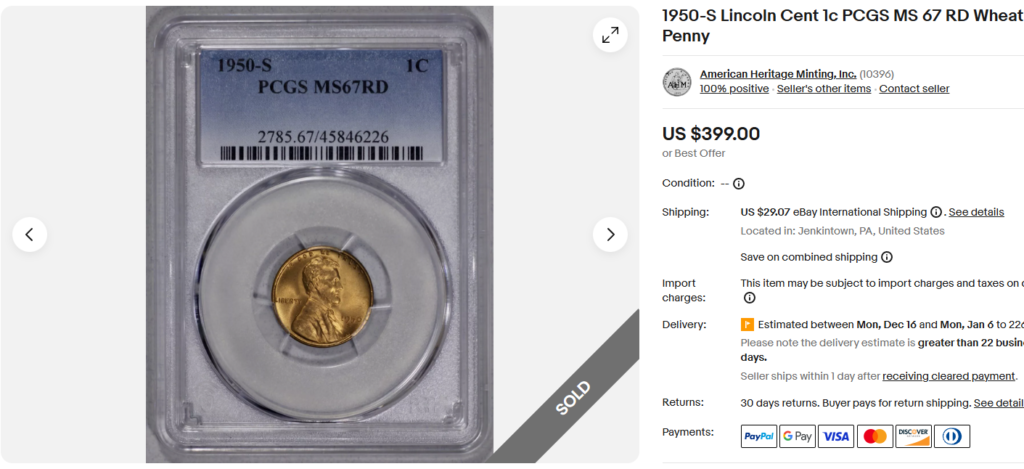
The finest known examples in MS-68+ have crossed the remarkable $10,500 price point, like this MS68 example of 1950-S penny sold for $10,800 at Heritage Auctions.
The color of your old copper penny is another conditional factor impacting its value. Generally, the coin has three designations based on the amount of toning.
- Red (RD): Red pennies retain at least 95% of their original mint color and have the vibrant orange-red surface. These coins command the highest premiums, often ranging from $10 to $5,000 or more, especially in MS-65 and above. Highest-grade Red 1950 cents can fetch over $10,000!
- Red-Brown (RB): These coins show a mix of both brown and red due to 15% to 94% of the original red color remaining. These coins typically sell for about 60% of their full Red counterparts. Generally, An 1950 RB pennies fetch $5-120, in MS65 to MS68 grades.
- Brown (BN): Brown coins have only less than 15% of their original red color and are worth the lowest among all. They generally fetch $5-15 in mint state unless they are in an exceptional condition or exhibit a rare flaw (mint error).
2. 1950 Lincoln Cent Mint Marks
| Coin Grades | Condition Details | 1950 No Mint Mark Penny Value | 1950 D Wheat Penny Value | 1950 D Wheat Penny Value |
| Poor (0) to Extremely Fine (XF45) | Significant wear, faded but visible details | 1-3 cents | 1-3 cents | 2-5 cents |
| Almost Uncirculated (AU50) to Mint State (AU58+) | Slight wear on highest points, visible marks or blemishes | 20 cents to 50 cents | 10 cents to 30 cents | 20 cents to 50 cents |
| Mint State (MS60 – MS64) | Uncirculated with minimal wear | $6 – $10 | $3 – $10 | $2 – $10 |
| Mint State (MS65 – MS66+) | Nearly flawless with very minor imperfections | $10 – $175+ | $10 – $100 | $10 – $150 |
| Mint State (MS67 – MS67+) | Well-preserved with no major flaws | $400 – $10,575+ | $450 – $3,840+ | $170 – $1,980+ |
| Mint State (MS68 or Above) | Nearly perfect, luster, no major marks or flaws | N/A | N/A | Up to $10,800+ |
The 1950 Lincoln Wheat penny was produced at three different mints with a combined mintage of 1,178,657,000 pieces. However, each mint’s production had its own characteristics and value profile.
1950 No Mint Mark Penny Value (Mintage – 272,635,000)
The Philadelphia Mint, producing coins without a mint mark, struck over 272 million pennies in 1950. These coins are generally worth only a few cents in the circulated condition, while uncirculated Red 1950 no mint mark penny examples can fetch $5 to $150 in MS64 to MS66 grades.
The rarest MS67 and MS67+ examples can reach $400 to $10,000, like this MS67+RD no mint mark penny sold for $10,575 at Legend Rare Coin Auctions!
1950 D Lincoln Penny Value (Mintage – 334,950,000)

The Denver Mint minted over almost 335 million 1950 cents, identified by the D mint mark. While circulated 1950 D pennies are still worth a few cents, uncirculated coins can be slightly more valuable.
For example, MS64 to MS66 examples of 1950 D Lincoln cent can fetch $8 to $100 and MS67 examples can command $350 to $1,000 with rarer MS67+ pennies reaching $3,800. The most expensive MS67+ 1950 D penny was bought for $15,275 in MS67 on Heritage Auctions!
1950 S Wheat Penny Value (Mintage – 118,505,000)
The San Francisco Mint released the lowest number of 1950 Lincoln cents, only reaching about 118.5 million mark, identified by the S mint mark. Due to the lowest mintage, the 1950 S penny is the most collectible of all.
As for the value, it ranges from $12 to $150 in MS64 to MS66+ grades and $170 to $1,900 in MS67 and MS67+ grades. The rare MS68 specimens can range from $2,500 to $10,800.
3. 1950 Lincoln Wheat Penny Proof
The Philadelphia Mint also released 51,386 proof Lincoln cents in 1950. These specially struck coins exhibit superior detail and finish compared to circulation strikes, with deeply mirrored fields and sharp design elements.
Regular proof specimens display brilliant surfaces and exceptional detail, typically selling for $20-30 in PR-63, $30-80 in PR-64, $50-200 in PR-65 and PR66 grades. The rarer PR67 and PR68 examples, especially with Red specimens, command the highest premiums of $230 to $1,400!
Cameo proofs, showing strong contrast between mirrored fields and frosted devices, are particularly desirable. These pieces typically bring 50-100% premiums over regular proofs. The value ranges from $100 to $6,600 depending on grades!
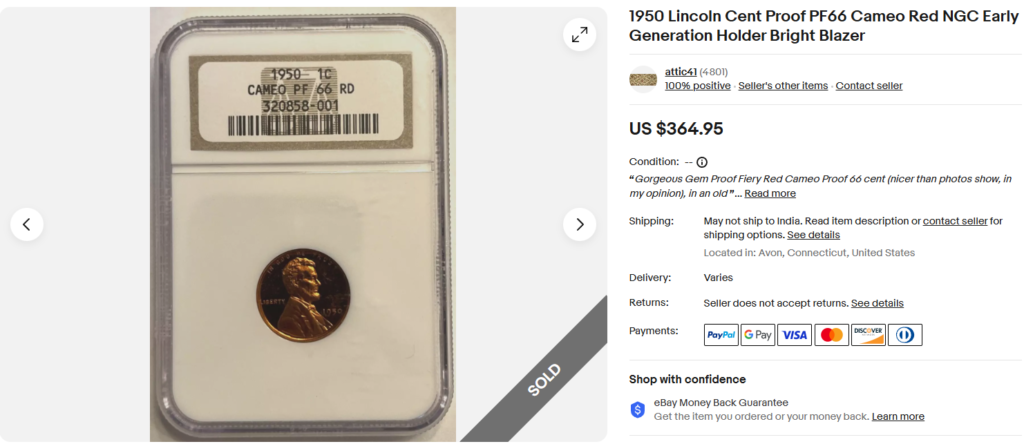
Deep Cameo examples can command prices three to five times higher than standard proofs. For instance, PR65 DCAM specimens $500 to $750, PR66 examples $700 to $4,500, and PR67 DCAM examples are $1,500 to $13,800!
The most valuable PR69RD 1950 S penny proofs can fetch exceptional prices of up to $19,500, like this stunning example sold for $19,975 at Heritage Auctions!
4. Rare 1950 Lincoln Penny Errors
The 1950 Lincoln Wheat penny series includes several valuable error varieties that command significant premiums. Double Die errors show distinct doubling in the lettering or design elements, with strong examples bringing $100-500 premiums depending on the doubling’s prominence.
Off-center Strike
Off-center strikes represent another error, in which a part of the design is missing due to misplacement of the planchet. The value of off-center 1950 pennies ranges from $25-50 for minor off-center strikes of 5-10%, and $100-300 for more dramatic examples.
For example, an MS63RD 1950-D coin with 60% off center sold for $125 on eBay. Another rare example is a MS64BN coin with 40% off center, and it was bought for a stunning price of $720 on Heritage Auctions!

Struck on a Silver Dime Planchet
In this rare error, a silver dime planchet accidentally enters the minting press and strikes a 1950 Lincoln press design on it, resulting in a silver penny that is gray in color, smaller in size, and weighs 2.5 grams instead of 3.11 grams.
These error coins are extremely rare and, hence, can fetch premium prices of up to a few thousands, based on condition. For example, an MS64 1950 Penny struck on silver dime sold for a whopping $3,840 at Heritage Auctions!
Repunched Mint Mark (FS-504)
In this error, the minting die strike the mint mark on a 1950 Lincoln cent more than once, resulting in a doubled (or tripled) mark. You can spot this by any extra lines or curves on the mint mark.
The value of 1950 Penny RPMs can range from $40 to a few hundred dollars, depending on the clarity of the error. For example, an MS66 Red 1950-S/S Repunched Mintmark penny sold for almost $105 in a coin auction at Heritage Auctions! Another example is this MS65RD 1950-D/D Wheat Cent Penny sold for $55 on eBay!
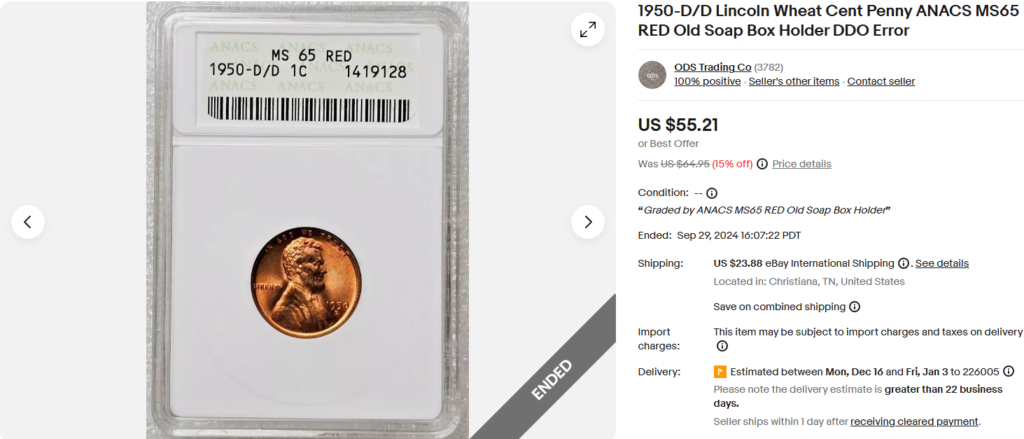
In addition to these, look for other common errors, like DDO error, BIE error (die crack), cud die break error, and curved clip on your 1950 Lincoln cent. Remember, while a regular cent will be a small amount, high quality and grades and rare features can double or tripe its value!

